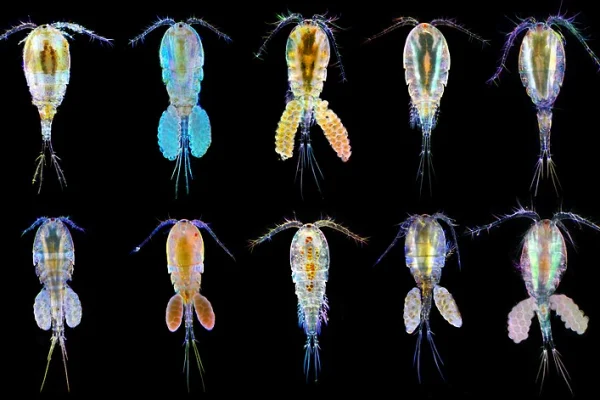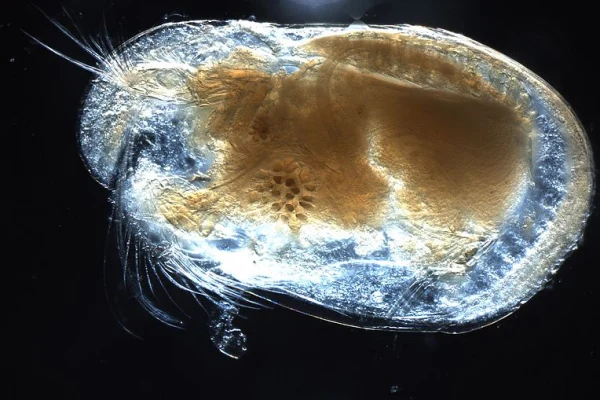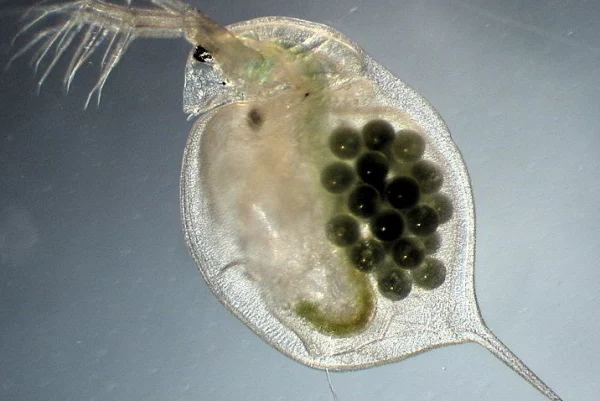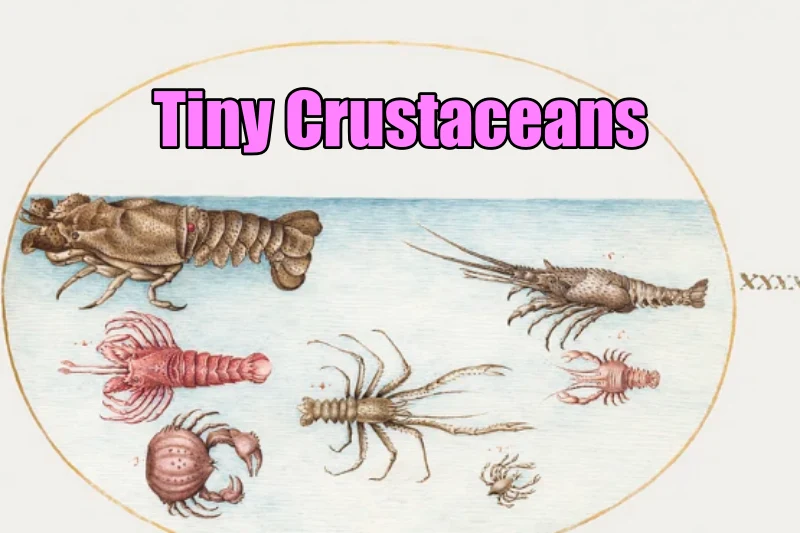The variety of life forms in the aquatic world never ceases to astound us. Crustaceans, a class of arthropods, are one such group of organisms. These arthropods have a characteristic segmented body and a rigid exoskeleton. Now tell me if you have ever wondered just how tiny the tiniest known crustacean might be. What if I told you that it is not even 0.1 mm? Surprising, no? and fascinating at the same time. Therefore, we have come up with this article that includes 10 tiny crustaceans obviously without ignoring any of their outstanding features. The purpose is to comprehend how these organisms survive in their surroundings despite numerous risks to their existence.
10 Surprisingly Tiny Crustaceans
1. Stygotantulus Stocki
- Scientific name – Stygotantulus stocki
- Size – 0.1 mm
- Diet – free-living larvae
This species is not only the smallest crustacean but also the smallest arthropod on the planet. It is also the only species in its genus. The engaging details don’t end here: Stygotantulus stocki got its name after its discoverer, a Dutch carcinologist, Jan Hendrik Stock.
It is an ectoparasite that feeds on harpacticoid copepods. This organism grows to a maximum length of 0.1 millimeters (0.004 inches).
2. Copepod

- Scientific name – Sphaeronellopsis monothrix
- Size – 0.11 mm
- Diet – diatoms and other phytoplankton
The world’s oceans are home to some 13,000 different species of copepods, free-living marine organisms. Copepods play a crucial role in the marine food chain.
While Most copepods range in size from 0.5 to 2 mm, Sphaeronellopsis monothrix (male), a parasite of marine ostracods is one of the smallest, growing to a maximum length of only 0.11 mm. As a result, it merits the second place on our list of the smallest crustaceans.
3. Ostracod

- Scientific name – Ostracoda
- Size – 0.2 to 30 mm
- Diet –algae and organic detritus
Ostracods, commonly referred to as seed shrimp, are tiny crustaceans that may range in size from 0.2 to 30 mm but are typically about 1 mm in size. Their bodies are mostly flattened side to side and covered with a “shell” or valve resembling a bivalve, commonly composed of calcium carbonate and chitin.
Are you curious why they go by the nickname “seed shrimp”? Because they resemble shrimp inside the seed pods. Their bodies flex like clams, allowing them to vanish into their pods so that only their antennae are visible. The feather-like antennae protrude out of the open pod to move, feel, and feed.
4. Daphnia

- Scientific name – Daphnia magna
- Size – 0.2 to 6.0 mm
- Diet – small, suspended particles in the water
The Daphnia genus comprises tiny planktonic crustaceans with a length ranging between 0.2 to 6.0 mm. As a member of the Anomopoda order, they are among the various small aquatic crustaceans that go by the name “water fleas” because of how they swim, similar to that of a flea.
People commonly use Daphnia for removing algae “bloom” from fish tanks due to their consumption of bacteria, tiny algae particles, and granular debris. As suspension feeders (or filter feeders), daphnia wolf down minute, suspended particles in the water.
5. Amphipod
- Scientific name – Amphipoda
- Size – 3.5 to 8 mm
- Diet – benthic organic matter
An order of malacostracan crustaceans, the Amphipoda lacks a carapace and typically has laterally compressed bodies. They usually inhabit caves, sandy beaches, lakes, rivers, and moist (warm) environments on numerous tropical islands.
Although they primarily consume organic debris found on the benthic layer, these animals will also occasionally scavenge and hunt other species.
Some of its small species are Talitroides topitotum, which is 7 mm long, Arcitalitrus sylvaticus (Haswell), which is approximately 8 mm, and Talitroides allaudi, roughly 3.5 mm in size.
6. Tiny Isopod (Idotea balthica)
- Scientific name – Idotea balthica
- Size – 18 to 30 mm
- Diet – vegetation like algae
Idotea balthica is a marine isopod that feeds on seaweed and seagrass within the subtidal zone of rocky coastlines and sandy lagoons. This baltic isopod has a uniform green or brown color body that is a little elongated, oblong or oval, and dorso-ventrally flattened.
These are rather tiny crustaceans where adult males can reach a length of 30 mm, while females can only attain 18 mm.
7. Tantulocarida (Arthropod)
- Class – Tantulocarida
- Size – 85 mm
- Diet – body fluids of certain copepods, isopods, ostracods, etc.
This group of tiny parasitic crustaceans has roughly 33 highly specialized species.
As ectoparasites, tantulocarida spend their whole lives stuck to the outside of their hosts, which can include a range of different marine crustaceans, such as copepods, isopods, tanaids, amphipods, and ostracods.
Tantulacus dieteri, a species of tantulocarid, has a total body length of about 85 mm, making it the tiniest arthropod in the world.
8. Brine Shrimp
- Scientific name – Artemia
- Size – 8 to 12 mm
- Diet – planktonic algae
The brine shrimp genus Artemia has seven to nine species. With a segmented body and broad, leaf-like appendages attached, Artemia is a typical primitive arthropod.
The adult male’s total length is about 8–10 mm, while the female’s is 10–12 mm. Both sexes’ width, including the legs, is about 4 mm.
The body of Artemia divides into the head, thorax, and abdomen. A thin, flexible chitin exoskeleton covers the entire body, to which muscles internally link and it sheds regularly.
9. Fairy Shrimp
- Scientific name – Anostraca
- Size – 6 to 25 mm
- Diet – algae, flatworm eggs and Arcella
Fairy shrimp are members of the order Anostraca, one of the four orders of crustaceans in the class Branchiopoda. They live around the world in deserts, ice-covered mountain lakes, Antarctic ice, and vernal pools and hypersaline lakes. Their size lies usually between 6–25 mm.
What makes fairy shrimp unique? Certain species have developed the capacity to hatch, reach sexual maturity in just 7 days, and generate more than 6000 embryos in their brief 30-day lifespan.
10. Krill
- Scientific name – Euphausiacea
- Size – 1 to 2 cm
- Diet –phytoplankton, microscopic, single-celled plants
Krill is a small marine crustacean living around in every ocean on Earth. The word “krill” originates from the Norwegian word “krill,” which means “small fry of fish”. They are the primary food source for many larger creatures, while they graze mostly on phytoplankton and, to a lesser extent, zooplankton themselves.
Adult krill typically measure 1-2 cm in length. A few species reach size of between 6 and 15 cm.
Conclusion
Despite being sometimes overlooked because of their small size, tiny crustaceans are important members of the complex web of aquatic life. These microscopic organisms, which include krill and fairy shrimp, maintain the equilibrium of freshwater and marine ecosystems as well as moist terrestrial settings.
They are essential to the food chain, the cycling of nutrients, and the general health of ecosystems because of their vast numbers and diverse range of adaptations. We are ending our article on this note. Check back often on our website for more such articles.
Also Read:

Anjali Prasad, a B. Pharm. graduate who works as a content writer for HowItSee, is based in Delhi. Except for her, not many people take the typical road from healthcare to writing. Her love of writing stemmed from her involvement in the college literature society and her early journaling at the age of 7. Hence, the love of learning and the spirit of exploration are what drew her to this career. You can find her on common social media like Instagram.
